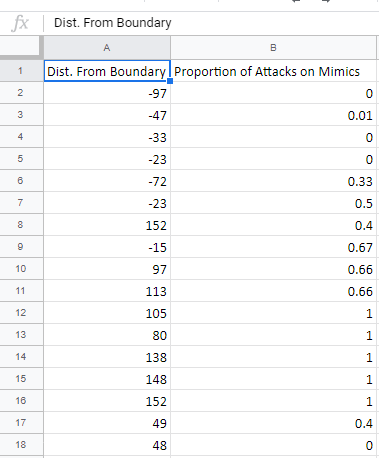fx Dist. From Boundary A Dist. From Boundary Proportion of Attacks on Mimics 2 -97 3 -47 0.01 4 -33 -23 -72 0.33 -23 0.5 152 0.4 -15 0.67 10 97 0.66 11 113 0.66 12 105 13 80 14 138 15 148 16 152 17 49 0.4 18 48
Addition Rule of Probability
It simply refers to the likelihood of an event taking place whenever the occurrence of an event is uncertain. The probability of a single event can be calculated by dividing the number of successful trials of that event by the total number of trials.
Expected Value
When a large number of trials are performed for any random variable ‘X’, the predicted result is most likely the mean of all the outcomes for the random variable and it is known as expected value also known as expectation. The expected value, also known as the expectation, is denoted by: E(X).
Probability Distributions
Understanding probability is necessary to know the probability distributions. In statistics, probability is how the uncertainty of an event is measured. This event can be anything. The most common examples include tossing a coin, rolling a die, or choosing a card. Each of these events has multiple possibilities. Every such possibility is measured with the help of probability. To be more precise, the probability is used for calculating the occurrence of events that may or may not happen. Probability does not give sure results. Unless the probability of any event is 1, the different outcomes may or may not happen in real life, regardless of how less or how more their probability is.
Basic Probability
The simple definition of probability it is a chance of the occurrence of an event. It is defined in numerical form and the probability value is between 0 to 1. The probability value 0 indicates that there is no chance of that event occurring and the probability value 1 indicates that the event will occur. Sum of the probability value must be 1. The probability value is never a negative number. If it happens, then recheck the calculation.
Attached in the attachment is the datset for this question:
Batesian mimicry occurs when a non-toxic or harmless organism looks highly similar to an organism that is toxic or venomous. An example is the viceroy butterfly which is harmless, but looks extremely similar to the monarch butterfly, which is toxic and bad-tasting when eaten. As a result of the similarity, the harmless organism may be avoided by predators. Bright colors are often advertisements for toxicity, to alert predators to avoid the animal.
Another familiar example are coral and king snakes. Coral snakes have highly toxic venom, but king snakes are harmless. A common means for distinguishing the two is, "red touches yellow, you're a dead fellow. Red touches black, you're okay, Jack." But is the similarity as useful in the extreme reaches of the snakes'
Here is a link to a Google Sheet of the dataset.
"Dist. From Boundary" is the distance in kilometers from the edge of the coral snakes' range; negative numbers mean within the range, positive numbers are outside.
"Proportion of Attacks on Mimics" is the proportion of attacks on artificial mimic snakes vs. artificial non-mimics by predators.
Use the data set to perform a linear regression relating distance from the boundary to the proportion of attacks on mimics. Use your regression formula to predict the proportion of attacks on mimics at -50 kilometers from the boundary. Report your answer to two decimal places.

Trending now
This is a popular solution!
Step by step
Solved in 3 steps with 5 images




